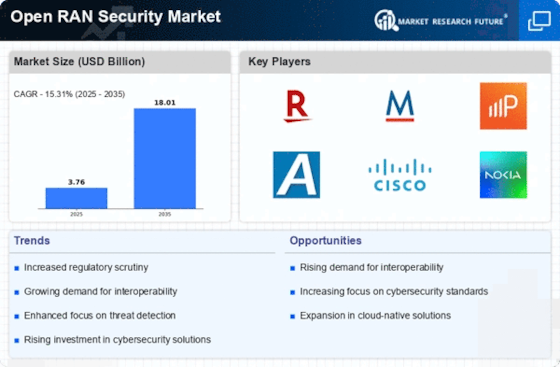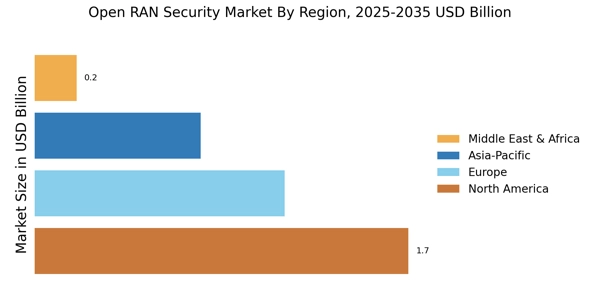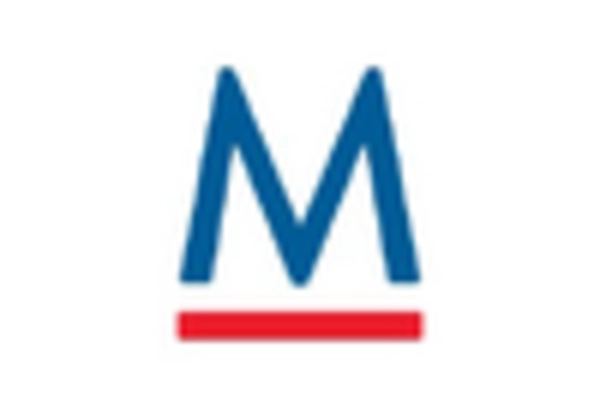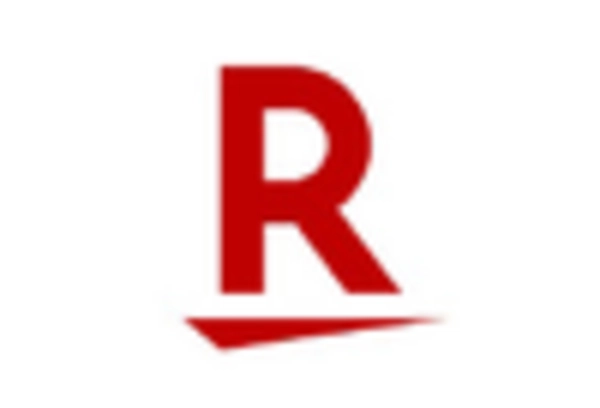Emergence of 5G Technology
The advent of 5G technology is a pivotal driver for the Open Ran Security Market. With the rollout of 5G networks, there is an escalating need for enhanced security measures to protect sensitive data and maintain network integrity. The Open RAN framework, which promotes interoperability among various vendors, presents both opportunities and challenges in terms of security. As 5G adoption accelerates, the Open Ran Security Market is expected to witness a significant uptick in demand for security solutions tailored to this new environment. Analysts project that the market for 5G-related security solutions could reach USD 10 billion by 2027, underscoring the urgency for operators to implement comprehensive security strategies that align with the Open RAN paradigm.
Growing Regulatory Pressures
The Open Ran Security Market is increasingly influenced by growing regulatory pressures aimed at enhancing cybersecurity across telecommunications networks. Governments worldwide are implementing stricter regulations to protect consumer data and ensure network reliability. These regulations often require operators to adopt specific security frameworks and standards, which in turn drives demand for security solutions within the Open RAN ecosystem. As compliance becomes a priority, the Open Ran Security Market must adapt to meet these evolving requirements. The potential for non-compliance penalties further incentivizes operators to invest in security measures, thereby expanding the market for Open RAN security solutions. It is anticipated that regulatory compliance expenditures in the telecommunications sector could reach USD 5 billion by 2026, highlighting the urgency for operators to align their security strategies with regulatory expectations.
Adoption of Cloud-Native Solutions
The shift towards cloud-native solutions is a transformative trend impacting the Open Ran Security Market. As operators increasingly migrate their network functions to the cloud, the security landscape evolves, necessitating new approaches to safeguarding data and infrastructure. Cloud-native architectures offer scalability and flexibility, but they also introduce unique security challenges that must be addressed. The Open Ran Security Market is poised to benefit from this transition, as operators seek security solutions that can effectively protect cloud-based environments. Market analysts suggest that the cloud security market could grow to USD 35 billion by 2027, indicating a robust demand for security solutions that cater to the specific needs of Open RAN deployments. This trend underscores the importance of developing comprehensive security strategies that encompass both traditional and cloud-native environments.
Rising Demand for Network Flexibility
The Open Ran Security Market is experiencing a notable surge in demand for network flexibility. As telecommunications operators seek to enhance their service offerings, the adoption of Open Radio Access Networks (Open RAN) is becoming increasingly prevalent. This shift allows for the integration of diverse hardware and software components, fostering innovation and reducing vendor lock-in. According to recent estimates, the Open RAN market is projected to grow at a compound annual growth rate (CAGR) of over 20% through 2026. This growth is indicative of a broader trend where operators prioritize adaptable network architectures to meet evolving consumer needs. Consequently, the Open Ran Security Market must address the unique security challenges that arise from this increased flexibility, ensuring robust protection against potential vulnerabilities.
Increased Investment in Telecommunications Infrastructure
Investment in telecommunications infrastructure is a critical driver for the Open Ran Security Market. Governments and private entities are channeling substantial resources into upgrading existing networks and deploying new ones, particularly in underserved regions. This investment is often accompanied by a focus on security, as stakeholders recognize the importance of safeguarding their infrastructure against cyber threats. The Open RAN model, which allows for a more cost-effective deployment of network components, is particularly appealing in this context. As a result, the Open Ran Security Market is likely to benefit from increased funding and initiatives aimed at enhancing security protocols within these newly established networks. Reports indicate that infrastructure spending in telecommunications could exceed USD 1 trillion by 2025, further emphasizing the need for robust security measures.


















Leave a Comment